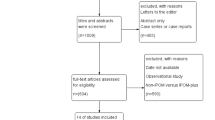Abstract
Laparoscopic ventral hernia repair (LVHR) has grown in popularity. Typically, this procedure is performed with a mesh bridge technique that results in high rates of seroma, eventration (bulging), and patient dissatisfaction. In an effort to avoid these complications, there is growing interest in the role of laparoscopic primary fascial closure with intraperitoneal mesh placement. This systematic review evaluated the outcomes of closure of the central defect during LVHR. A literature search of PubMed, Cochrane databases, and Embase was conducted using PRISMA guidelines. MINORS was used to assess the methodologic quality. Primary outcome was hernia recurrence. Secondary outcomes were surgical-site infection, seroma formation, bulging, and patient-centered items (satisfaction, chronic pain, functional status). Eleven studies were identified, eight of which were case series (level 4 data). Three comparative studies examined the difference between closure and nonclosure of the fascial defect during laparoscopic ventral incisional hernia repairs (level 3 and 4 data). These studies suggested that primary fascial closure (n = 138) compared to nonclosure (n = 255) resulted in lower recurrence rates (0–5.7 vs. 4.8–16.7 %) and seroma formation rates (5.6–11.4 vs. 4.3–27.8 %). Follow-up periods for both groups were similar (1–108 months). Only one study evaluated patient function and clinical bulging. It showed better outcomes with primary fascial closure. Closure of the central defect during LVHR resulted in less recurrence, bulging, and seroma than nonclosure. Patients with closure were more satisfied with the results and had better functional status. The quality of the data was poor, however. A randomized controlled trial to evaluate the role of closure of the central defect during LVHR is warranted.

Similar content being viewed by others
References
Santora TA, Roslyn JJ (1993) Incisional hernia. Surg Clin North Am 73:557–570
Clapp ML, Hicks SC, Awad SS et al (2012) Trans-cutaneous closure of central defects (TCCD) in laparoscopic ventral hernia repairs (LVHR). World J Surg 37:42–51. doi:10.1007/s00268-012-1810-y
Pierce RA, Spitler JA, Frisella MM et al (2007) Pooled data analysis of laparoscopic versus open ventral hernia repair: 14 years of patient data accrual. Surg Endosc 21:378–386
Heniford BT, Park A, Ramshaw BJ et al (2003) Laparoscopic repair of ventral hernias: nine years’ experience with 850 consecutive hernias. Ann Surg 238:391–399 discussion 399–400
LeBlanc KA (2005) Incisional hernia repair: laparoscopic techniques. World J Surg 29:1073–1079
Leber GE, Garb JL, Albert AI et al (1998) Long-term complications associated with prosthetic repair of incisional hernias. Arch Surg 132:1141–1144
Sampsel J (1976) Delayed and recurring infection in postoperative abdominal wounds. Am J Surg 132:316–319
Temudom T, Siadati M, Sarr MG (1996) Repair of complex giant or recurrent ventral hernias by using tension-free intraparietal prosthetic mesh (Stoppa technique): lessons learned from our initial experience (fifty patients). Surgery 120:738–744
White TJ, Santos MC, Thompson JS (1998) Factors affecting wound complications in repair of ventral hernias. Am Surg 64:276–280
Sauerland S, Walgenbach M, Habermalz B et al (2011) Laparoscopic versus open surgical techniques for ventral or incisional hernia repair. Cochrane Database Syst Rev 16(3):CD007781
Itani KF, Hur K, Kim LT et al (2010) Comparison of laparoscopic and open repair with mesh for the treatment of ventral incisional hernia: a randomized trial. Arch Surg 145:322–328
Agarwal BB, Agarwal S, Gupta MK et al (2008) Laparoscopic ventral hernia meshplasty with ‘‘doublebreasted’’ fascial closure of hernial defect: a new technique. J Laparoendosc Adv Surg Tech A 18:222–229
Tse GH, Stutchfield BM, Duckworth AD et al (2010) Pseudo-recurrence following laparoscopic ventral and incisional hernia repair. Hernia 14:583–587
Moher D, Liberati A, Tetzlaff J et al (2009) Preferred reporting items for systematic reviews and meta-analyses: the PRISMA statement. BMJ 339:b2535
Slim K, Nini E, Forestier D et al (2003) Methodological index for non-randomized studies (MINORS): development and validation of a new instrument. ANZ J Surg 73:712–716
Zeichen MS, Lujan HJ, Mata WN et al (2013) Closure versus non-closure of hernia defect during laparoscopic ventral hernia repair with mesh. Hernia 17:589–596
Banerjee A, Beck C, Narula VK et al (2012) Laparoscopic ventral hernia repair: does primary repair in addition to placement of mesh decrease recurrence? Surg Endosc 26:1264–1268
Orenstein SB, Dumeer JL, Monteagudo J et al (2011) Outcomes of laparoscopic ventral hernia repair with routine defect closure using “shoelacing” technique. Surg Endosc 25:1452–1457
Palanivelu C, Jani KV, Senthilnathan P et al (2007) Laparoscopic sutured closure with mesh reinforcement of incisional hernias. Hernia 11:223–228
Chelala E, Thoma M, Tatete B et al (2007) The suturing concept for laparoscopic mesh fixation in ventral and incisional hernia repair: mid-term analysis of 400 cases. Surg Endosc 21:391–395
Franklin ME, Gonzalez JJ, Glass JL et al (2004) Laparoscopic ventral and incisional hernia repair: 11-year experience. Hernia 8:23–27
Rea R, Falco P, Izzo D et al (2012) Laparoscopic ventral hernia repair with primary transparietal closure of the hernia defect. BMC Surg 12(Suppl 1):S33
Allison N, Tieu K, Snyder B et al (2012) Technical feasibility of robot-assisted ventral hernia repair. World J Surg 36:447–452. doi:10.1007/s00268-011-1389-8
Agarwal BB, Agarwal S, Mahajan KC (2009) Laparoscopic ventral hernia repair: innovative anatomical closure, mesh insertion without 10-mm transmyofascial port, and atraumatic mesh fixation: a preliminary experience of a new technique. Surg Endosc 23:900–905
Ventral Hernia Working Group: Breuing K, Butler CE, Ferzoco S et al (2010) Incisional ventral hernias: review of the literature and recommendations regarding the grading and technique of repair. Surgery 148:544–558
Kurmann A, Visth E, Candinas D et al (2011) Long-term follow-up of open and laparoscopic repair of large incisional hernias. World J Surg 35:297–301. doi:10.1007/s00268-010-0874-9
Liang MK, Subramanian A, Awad S (2012) Laparoscopic transcutaneous closure of central defects in laparoscopic incisional hernia repair. Surg Laparosc Endosc Percutan Tech 22:e66–e70
Carter SA, Hicks SC, Brahmbhatt R et al (2014) Recurrence and pseudorecurrence after laparoscopic ventral hernia repair: predictors and patient-focused outcomes. Am Surg 80:138–148
Author information
Authors and Affiliations
Corresponding author
Rights and permissions
About this article
Cite this article
Nguyen, D.H., Nguyen, M.T., Askenasy, E.P. et al. Primary Fascial Closure With Laparoscopic Ventral Hernia Repair: Systematic Review. World J Surg 38, 3097–3104 (2014). https://doi.org/10.1007/s00268-014-2722-9
Published:
Issue Date:
DOI: https://doi.org/10.1007/s00268-014-2722-9




